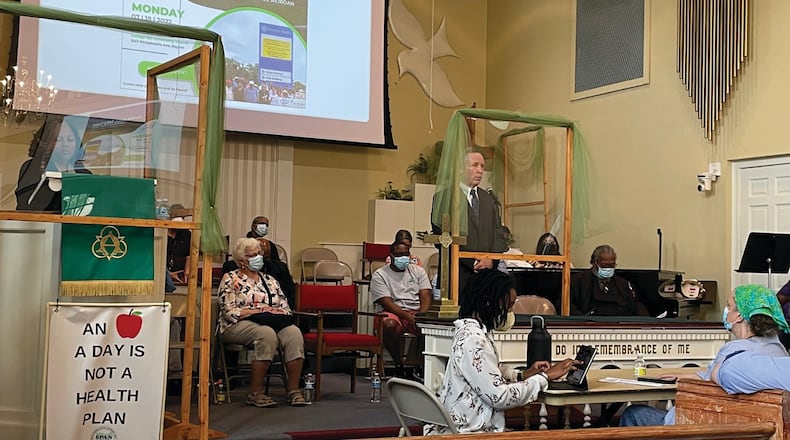“I appreciate … the thought that I’m a new CEO, but I am the CEO. This is not about anyone else before me,” Riordan said after organizers mentioned the previous CEO, Mary Boosalis. “I own that decision, and it’s my responsibility to take what is here now and move us through it.”
Rev. Dr. Merritt Worthen, president of the coalition, talked about fighting the decision to close the hospital in West Dayton, including the coalition and Advocates For Basic Legal Equality (ABLE) filing a federal complaintl. The U.S. Department of Health and Human Services’ Office for Civil Rights “did not find sufficient evidence” to prove a civil rights violation, according to a letter from the department in March 2022.
Good Samaritan Hospital served an area with a population of 38,600, approximately 75% of whom are Black.
“From the county to the city to the state, they said that, ‘Racism is a public health emergency.’ And it is an emergency in northwest Dayton,” said Bishop Richard Cox, vice president of the Clergy Community Coalition.
Attendees highlighted racial and economic disparities between West Dayton and locations of Premier Health’s newer facilities, including Miami Valley Hospital’s new Beavercreek Emergency Center. Beavercreek’s population is about 46,500, with 84.7% white and 2.8% Black, according to the U.S. Census. The median household income in Beavercreek is about $94,600 with 7.2% of people living in poverty, compared to Dayton, where median household income is $34,400 with a 29.6% poverty rate.
Beavercreek also already had Soin Medical Center - Kettering Health. Premier’s Beavercreek Emergency Center is less than two miles from Soin.
“While we are forced to wait on the west side of Dayton, Premier Health steadily builds hospitals and medical centers in affluent, white neighborhoods,” Worthen said.
Riordan emphasized that Premier Health plans to stay in West Dayton, and a 12,000-square-foot medical center will be one of the locations to fill the Good Samaritan site as part of the Phoenix Next reuse plan. The center will have an urgent care center, physician offices, physical therapy, lab services and medical imaging.
“It’s a project that I fully support,” Riordan said.
Riordan also spoke about plans to “reorient the building” so officials can possibly add services in a few years to the urgent care.
“Let’s reorient it so that we can grow,” Riordan said.
For residents, the urgent care isn’t enough to replace the much larger, full-service hospital, which also had more than 3,000 employees and more than 500 beds, attendees said. From the town hall’s locationon Monday, it would be a 10-to-15-minute car ride and an approximate 40-minute bus ride to Miami Valley Hospital on Wyoming Street. To the old Good Samaritan site, it would be a 3-to-4-minute car ride and a 7-minute bus ride.
Riordan called the dialogue with the community on Monday “a move forward,” as well as “important feedback and input,” but he held firm to Premier Health’s urgent care plan. He added officials are “mid-cycle” on Premier’s strategic plan.
About the Author


